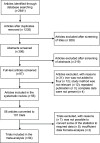Systematic review and meta-analysis of the effect of iron-fortified flour on iron status of populations worldwide
- PMID: 31486352
- PMCID: PMC10260631
- DOI: 10.1017/S1368980019002179
Systematic review and meta-analysis of the effect of iron-fortified flour on iron status of populations worldwide
Abstract
Objective: Assess the effectiveness of iron-fortified flour on iron status.
Design: Systematic review and meta-analysis.
Setting: Argentina, Australia, Azerbaijan, Bangladesh, Brazil, Cameroon, Chile, China, Costa Rica, Côte d'Ivoire, Denmark, India, Iran, Jordan, Kazakhstan, Kenya, Kuwait, Mongolia, Morocco, Norway, South Africa, Sri Lanka, Tajikistan, Thailand, UK, USA, Uzbekistan, Venezuela, Vietnam, and Zambia.
Participants: Fifty-two articles (ninety-four trials) were examined. The main target groups were women, children, and infants/toddlers. The effects of different types of iron-fortified flour (wheat, maize, rice, soy, and beans) on iron status were examined.
Results: A random effects analysis of before-after studies showed that iron-fortified flour led to significant increases of mean haemoglobin level (3·360 g/l; 95 % CI: 0·980, 5·730) and mean serum ferritin level (4·518 µg/l; 95 % CI: 2·367, 6·669); significant decreases of anaemia (-6·7 %; 95 % CI: -9·8 %, -3·6 %) and iron deficiency (ID) (-10·4 %; 95 % CI: -14·3 %, -6·5 %); but had no significant effect on iron deficiency anaemia (IDA). A random effects analysis of controlled trials indicated that iron-fortified flour led to significant increases of mean haemoglobin level (2·630 g/l; 95 % CI: 1·310, 3·950) and mean ferritin level (8·544 µg/l; 95 % CI: 6·767, 10·320); and significant decreases of anaemia (-8·1 %; 95 % CI: -11·7 %, -4·4 %), ID (-12·0 %; 95 % CI: -18·9 %, -5·1 %), and IDA (-20·9 %; 95 % CI: -38·4 %, -3·4 %).
Conclusions: Flour fortification with iron is an effective public health strategy that improves iron status of populations worldwide.
Keywords: Fortified flour; Iron status; Meta-analysis; Systematic review.
Figures
References
-
- World Health Organization (2015) The global prevalence of anaemia in 2011. http://www.who.int/nutrition/publications/micronutrients/global_prevalen... (accessed April 2019).
-
- World Health Organization (2018) Anaemia. http://www.who.int/topics/anaemia/en/ (accessed April 2019).
-
- GBD (2015) Disease and Injury Incidence and Prevalence Collaborators (2015) Global, regional, and national incidence, prevalence, and years lived with disability for 310 diseases and injuries, 1990–2015: a systematic analysis for the Global Burden of Disease Study 2015. Lancet 388, 1545–1602. - PMC - PubMed
-
- GBD 2016 Disease and Injury Incidence and Prevalence Collaborators (2017) Global, regional, and national incidence, prevalence, and years lived with disability for 328 diseases and injuries for 195 countries, 1990–2016: a systematic analysis for the Global Burden of Disease Study 2016. Lancet 390, 1211–1259. - PMC - PubMed
-
- World Health Organization (2014) Global nutrition targets 2025: policy brief series. http://www.who.int/nutrition/publications/globaltargets2025_policybrief_... (accessed April 2019).
Publication types
MeSH terms
Substances
LinkOut - more resources
Full Text Sources
Medical


